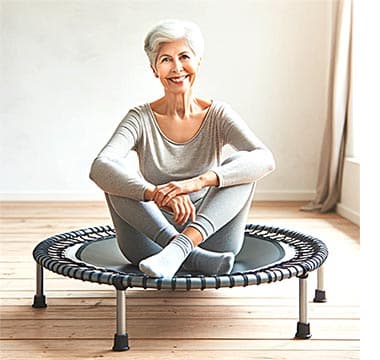In our last couple of Exercise blogs we have been suggesting outdoor activities like walking or biking. Realizing that the outdoors may be not be available to some of you due to weather or other health concerns, in this post we are looking at Rebounding.
Rebounding is a cardiovascular exercise typically performed on a mini trampoline. It is a low impact, full-body workout that is not only great for the body, but fun.
What can you expect from rebounding?
Studies by NASA scientists show that:
- Rebounding is 68% more effective than jogging and yet requires less effort
- 10 minutes jumping on a trampoline is a better cardiovascular workout than 33 minutes of running
- Trampolining also develops upper and lower body strength better than weight-lifting without the strain and it performs better than swimming as an all-around exercise
- Trampolining is a low-impact workout that helps relieve stress and anxiety, tone muscles and improve coordination
Researchers at the Cleveland Clinic in Ohio state that Rebounding will:
- Build strength
- Improve bone density
- Better your balance
- Be good for your heart
- Relieve stress
Rebounding works to keep the entire body, particularly the core, legs, glutes, and back muscles, toned and strong. It stimulates the lymphatic system, which helps flush out toxins and fight disease, and can also improve balance and coordination.
Bouncing enhances motor skills and provides a mental release, which can help relieve symptoms of anxiety.
It increases capacity for respiration, thus circulates more oxygen to the tissues.
Rebounding can assist in the rehabilitation of existing heart problems. It also benefits recovery from heart procedures, providing gentle, low impact circulation.
Rebounding increases the functional activity of the red bone marrow in the production of red blood cells.
Rebounding lowers circulating cholesterol and triglyceride levels. It can lower low-density lipoprotein (bad) in the blood and increase high-density lipoprotein (good) holding off the incidence of coronary artery disease.
Rebounding offers relief from neck and back pains, headaches, and other pain caused by lack of exercise. Exercising on a rebounder has been shown to benefit body alignment and posture. As well as enhancing digestion and elimination processes.
Rebounding allows for deeper and easier relaxation and sleep.
Excellent for Seniors
According to the home care experts at Griswold HomeCare in the US, the advantages of rebounding exercises is especially beneficial for seniors.
These benefits include:
Improves balance and confidence: Trampoline exercises help seniors become more stable and coordinated, which will help them avoid falls. The added confidence boost will also ensure they move forward with high self-esteem.
Improves blood circulation: Rebounder exercises push you upward with every bounce, which forces your muscles to compensate for gravity by requesting more energy from your blood. As this blood flows into your body, pain and soreness become less intense.
Boosts brain function: Higher levels of circulation can provide better blood levels to the brain, which can help improve focus and memory.
Decreases blood pressure: Stuck-together blood cells and hardening arteries can lead to blood clots and increased blood pressure. The movement of rebounding exercises can prevent these dangerous conditions and improve overall cardiovascular health.
Improves digestion: Rebounding exercises help regulate intestinal movements to allow your body to pass waste with minimal or no difficulty.
Reduces risk of diabetes: Jumping on a trampoline can lower your blood sugar levels, improve the work of insulin in your body, and increase insulin sensitivity.
Promotes weight loss: Rebounder exercises for elderly help your body muscles absorb more glucose from the blood. This ultimately results in reducing your body’s stored lipids.
Provides general health benefits: The health benefits for rebounding include, but are not limited to. reducing sciatica, improving lymphatic drainage, and benefitting skin-cell rehabilitation.
So let’s get started!
Depending on where you live, rebounding can be done both indoors and out (put the mini-trampoline on a patio or balcony to add fresh air). It can be done all year round and can pretty much be done by anyone who is ambulatory.
It does, however require the purchase of a mini-trampoline. Prices range from about $50 to several hundred dollars. We suggest starting with a basic model and then you can always upgrade. Depending on how fit you are the rebounders with Hand Bars can help you get started.
Once you are set up, now it’s just a matter of getting started.

You can find a large variety of workouts from beginner to advanced which you can watch and work out to on YouTube.






